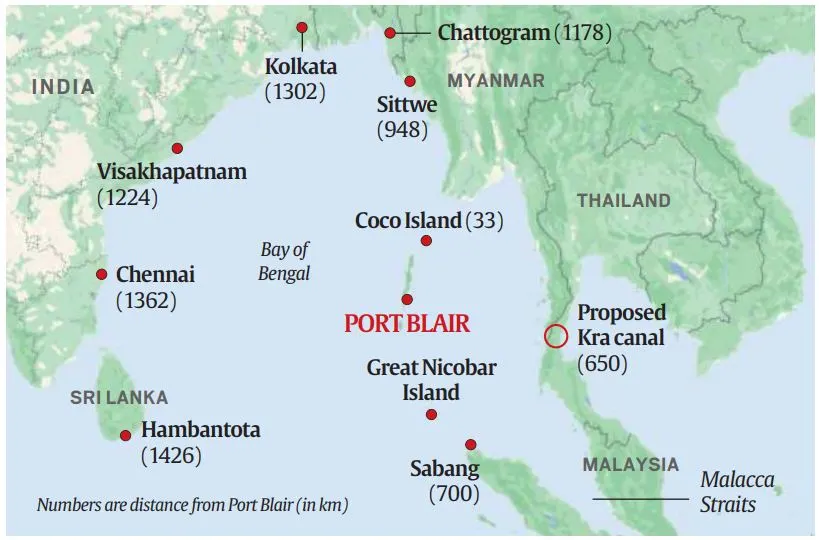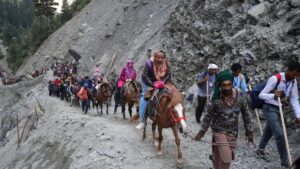Table of Contents
Hydrocarbons
Context: Hydrocarbons significantly impact the environment through CO2 emissions. Emissions occur throughout the hydrocarbon lifecycle (production, use, well abandonment)
| Fact |
| A 2018 study estimated oilfields releasing 1.7 billion tonnes of carbon dioxide in one year. |
How Hydrocarbons Are Formed and Extracted?
- Formation: Over millions of years, heat and pressure compress dead organic matter into hydrocarbons trapped in rock formations.
- Location:
- Hydrocarbons are found underground in reservoirs formed by layers of rock.
- Petroleum geologists assess these rocks for porosity (holding capacity) and permeability (ease of flow).
- The source of hydrocarbons is kerogen (organic matter) from lakes, oceans, or landmasses.
- Kerogen type determines the kind of hydrocarbon formed (oil, gas, coal).
- Extraction:
- Drilling and reservoir engineers aim to extract hydrocarbons efficiently without damaging the reservoir.
- A production well is drilled to maximise drainage. The well uses a drill bit, drill pipe, and drill collars.
- Steel casings and cement lining protect the well from collapsing and fluids entering.
- Drilling fluid cools the drill bit and carries rock cuttings to the surface.
- Blowout preventers control pressure and prevent uncontrolled eruptions.
- Mud-logging records rock cuttings by depth to study their properties.
- Drilling rigs can be used offshore on platforms.
- Well Completion and Production:
- Once drilled, the well is completed by removing the drill string and perforating the casing.
- Ideally, natural pressure pushes hydrocarbons to the surface through a narrower tube.
- If pressure is low, pump jacks or other methods lift hydrocarbons.
- Older wells may require workovers to maintain or improve production.
- Production Phases:
- Primary phase relies on natural pressure differences and buoyancy.
- Secondary phase uses injected water or diluents to maintain pressure and flow.
- Tertiary phase uses enhanced recovery methods like steam injection to extract remaining hydrocarbons.
- A well might yield around 15% each in primary, secondary, and tertiary phases.
- Well Abandonment and Decommissioning:
- Extraction ends before a well is completely depleted, often due to economic reasons.
- Abandoned wells are plugged to prevent contents from escaping. Plugs can be temporary or permanent.
- Improperly plugged wells are a major source of methane emissions.
- Decommissioning a well is expensive and not always commercially viable.
Wholesale Price Index (WPI)
Context: Wholesale price inflation rose to a 3-month high of 0.53% in March 2024, compared to 0.2% in February 2024.
More in News
Food Price Spike: The increase was driven by a rise in the food price index (4.65%), particularly:
- Cereals (9.04%): Highest 12-month increase
- Paddy (11.7%)
- Potato (53%)
- Onions (57%)
Pulses & Vegetables Remain High: Inflation in pulses (17.2%) and vegetables (19.5%) stayed elevated.
Fuel & Manufactured Goods Still Deflating: Prices of fuel and manufactured products continued to decline, though at a slower rate (around -0.8% each).
First Monthly Increase in 4 Months: Month-on-month, WPI rose 0.4% (first increase since November 2023).
Mixed Picture Within Food:
- Eggs, meat, and fish prices decreased (1.86%).
- Milk inflation eased (4.7%) but wheat prices rose sharply (7.43%).
Full Year Deflation: Despite the March rise, wholesale prices remained negative for the entire year (average -0.7%).
Concerns for the Future:
- Rising international commodity prices
- Potential increase in crude oil prices
- Impact of heatwaves on electricity demand
- Continued vegetable inflation
A&N Islands’ – Strategic importance
Context:
- India’s Look East policy has shifted to a more proactive Act East policy.
- Recognition of the importance of naval power and China’s growing navy has led to a focus on developing India’s island territories.
- The Andaman and Nicobar Islands (A&N Islands) are a strategically vital group of islands due to their location.
Strategic Importance of A&N Islands
- Location:
- 700 nautical miles southeast of mainland India.
- Less than a day’s steaming from the Malacca Strait (key waterway connecting Indian & Pacific Oceans).
- Close proximity to Myanmar, Thailand, Indonesia, and Bangladesh.
- Potential location for the mouth of a future Kra Canal connecting the Gulf of Thailand with the Andaman Sea.

- Role in Maritime Security:
- A&N Islands offer a vantage point for monitoring the Bay of Bengal.
- They can be the “first line of offence” against threats from the East.
- The Andaman and Nicobar Command (ANC) is a tri-services military command established in 2001.
Reasons for Slow Development of Strategic Infrastructure
- Delayed recognition of the islands’ strategic importance.
- Distance from the mainland and infrastructure challenges.
- Complexities of environmental clearances and land acquisition.
- Multi-agency coordination issues for large-scale development projects.
- Prioritisation of short-term political gains over long-term strategic vision.
Focus Areas for Strategic Infrastructure Development
- Maritime Security:
- Surveillance of the vast area around the islands.
- Securing all islands against occupation or illegal activities.
- Deterrence: Establish a strong deterrent against potential naval threats from the East.
- Economic Infrastructure: Develop infrastructure on the southern islands to boost maritime trade with Southeast Asia.
- Connectivity: Improve ease of travel within and between the islands to facilitate development and tourism.
- Self-Sufficiency: Reduce dependence on mainland India for supplies and services.
Specific Infrastructure Priorities
- Airfields: Separate airfields with long runways (suitable for Boeing 737s) in both north and south.
- Ports and Fuel Storage: Establish ports and fuel storage facilities in both island groups.
- Military Presence: Increase troop deployment and station the right mix of military assets at the ANC (surveillance aircraft, fighter jets).
- Galathea Bay (Great Nicobar Island) Transhipment Port: Expedite development for international and Indian shipping services.
- Transportation: Develop road networks, high-speed ferries, and a seaplane terminal.
- Faster Development: Utilise foreign materials and expertise for building weather-resistant and earthquake-proof infrastructure.
- Environmental Clearances: Streamline forest and environmental clearance processes for defence projects.
- Planned Habitation: Consider planned habitation of uninhabited islands with incentives for eco-friendly development.
- International Collaboration: Explore partnerships with Quad and Indo-Pacific Oceans Initiative (IPOI) for development assistance.
Climate Litigations
Context:
- The European Court of Human Rights ruled in favour of 2,000 Swiss women over the Swiss government’s inadequate climate change actions.
- This landmark ruling may set a precedent for European courts and encourage more communities to legally challenge their governments over climate change policies.
- The ruling coincides with India’s Supreme Court expanding citizens’ rights to include freedom from adverse effects of climate change.
Background
- A group of over 2,000 Swiss women above 64 (KlimaSeniorinnen Schweiz) sued the Swiss government in 2016.
- They argued the government’s weak climate policies violated their human rights under the European Convention on Human Rights.
- Their case focused on vulnerability to extreme heat as elderly women, referencing IPCC reports on health risks.
Court Ruling
- The European Court of Human Rights (ECHR) sided with the women.
- The court affirmed that Article 8 of the European Convention includes the right to state protection from serious climate change effects on individuals’ lives and well-being.
- Switzerland’s inadequate policies and failure to meet emission reduction goals breached this right.
- The ECHR cannot dictate specific policies but requires Switzerland to update its climate action plans.
Significance of the Ruling
- Sets a precedent for climate litigation in Europe (46 ECHR member states).
- National courts must consider this ruling in future climate and human rights cases.
- May encourage similar lawsuits in other ECHR member states.
- Reinforces the need for stronger climate action by governments.
Rise of Global Climate Litigation
- The Swiss case reflects a growing trend of climate lawsuits worldwide.
- As of December 2022, over 2,180 climate cases were filed globally.
- Diverse groups like youth, women, and indigenous communities are driving this trend.
- Recent examples include successful lawsuits against governments in Montana (US) and India (rejected).
Overall Impact
- The ECHR ruling is a major victory for climate activists and could lead to stricter climate policies in Europe.
- It highlights the increasing use of legal action to hold governments accountable for climate change.
Examples, Data and Case Studies For Value Addition
- Geography (GS 1): Mumbai’s Worli Koliwada will be the site for India’s second artificial reef installation, following Pondicherry, to enhance marine biodiversity.
- International Relation (GS 2): The Ministry of External Affairs (MEA) has approved a plan for India Ports Global Ltd (IPGL) to manage all operations at Sittwe port on Myanmar’s Kaladan River, marking India’s second international port venture following Chabahar Port.


 Operation Shiva 2025: Indian Army’s Ma...
Operation Shiva 2025: Indian Army’s Ma...
 World Youth Skills Day 2025, Theme, Hist...
World Youth Skills Day 2025, Theme, Hist...
 President Murmu Nominates Four Members t...
President Murmu Nominates Four Members t...





















